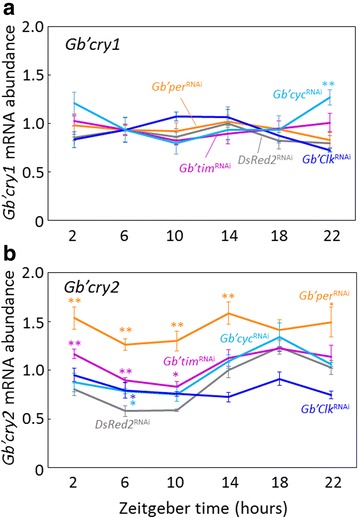Fig. 7.

Effects of RNAi of various clock genes on Gb’cry1 a and Gb’cry2 mRNA b in the cricket optic lobes. Adult male crickets (Gryllus bimaculatus) were treated with DsRed2 RNAi (gray), Gb’per RNAi (orange), Gb’tim RNAi (purple), Gb’Clk RNAi (blue), and Gb’cyc RNAi (light blue). The optic lobes were collected about 7 days after the dsRNA injection. The abundance of mRNA was measured by quantitative real-time RT-PCR with total RNA extracted from the optic lobes. The data collected from three and four independent experiments were averaged and plotted as mean ± SEM for clock gene dsRNA-injected and dsDsRed2-injected crickets, respectively. The abundance of Gb’rpl18a mRNA was used as an internal reference. The data for DsRed2 RNAi are replotted from Fig. 2. Asterisks indicate significant difference between DsRed2 RNAi crickets and those treated with clock gene dsRNAs: *P < 0.05, **P < 0.01, Dunnett’s test. Note that Gb’cry1 mRNA levels were never affected by RNAi of clock genes except for cyc RNAi at ZT22, and that Gb’cry2 mRNA levels showed a rhythmic expression after Gb’tim or Gb’cyc dsRNA treatments, but became arrhythmic when treated with Gb’per or Gb’Clk dsRNA. For further explanations, see the text
